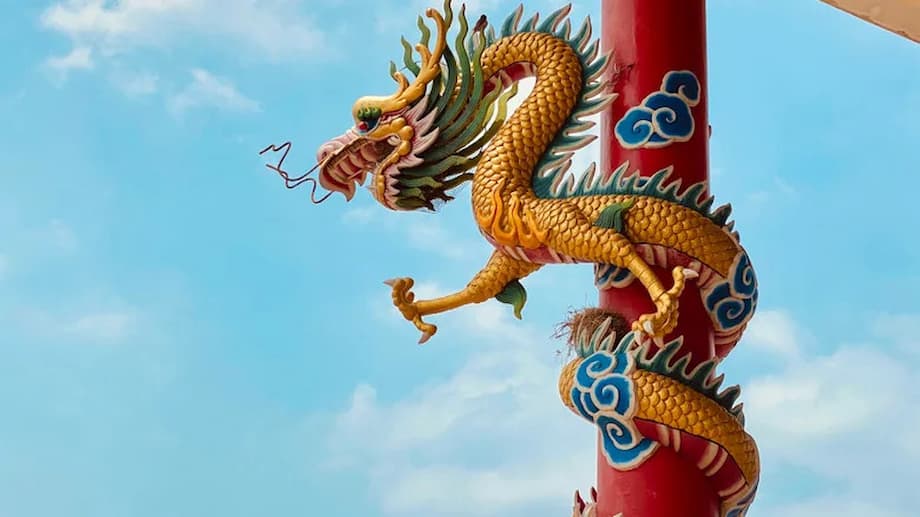The Discovery of a Real-Life ‘Dragon’ in China
In a remarkable fusion of science and mythology, paleontologists have unearthed a 240-million-year-old fossil in southern China that has captivated both the scientific community and the public imagination. The fossil belongs to Dinocephalosaurus orientalis, an extraordinary marine reptile whose elongated, snake-like neck and body bear a striking resemblance to the legendary Chinese dragon. This discovery not only sheds light on the diversity of prehistoric marine life but also bridges the worlds of paleontology and ancient cultural symbolism.
The fossil was discovered in the Guizhou Province, a region renowned for its rich deposits of Triassic-era fossils. While Dinocephalosaurus orientalis was first identified in 2003, the newly uncovered specimen is by far the most complete, stretching roughly 16 feet (about 5 meters) and providing the first full look at the creature’s unique anatomy. The international team behind this discovery included scientists from China, the United States, the United Kingdom, Germany, and other European countries, highlighting the global significance of the find.
What Makes Dinocephalosaurus orientalis Unique?
The most striking feature of Dinocephalosaurus orientalis is its neck, which contains an astonishing 32 vertebrae—more than any other known marine reptile from its era. This neck is not only longer than the animal’s body and tail combined but also gave the creature a remarkable degree of flexibility and reach. Unlike other long-necked marine reptiles, such as plesiosaurs, which evolved their necks by elongating existing vertebrae, Dinocephalosaurus achieved its length by adding more vertebrae. This evolutionary strategy resulted in a body plan that was both unique and highly specialized for aquatic life.
Its body was equipped with flipper-like limbs, indicating it was fully adapted to an oceanic lifestyle and likely incapable of moving efficiently on land. Fossilized fish remains found in its stomach confirm that it was a specialized underwater predator, using its long neck to stealthily approach and capture prey in crevices and narrow spaces beneath the water’s surface.
Dr. Nick Fraser, Keeper of Natural Sciences at National Museums Scotland and a member of the research team, described the discovery as a window into the “weird and wonderful world of the Triassic that continues to baffle paleontologists.” He emphasized the global fascination with the fossil, noting its “striking appearance, reminiscent of the long and snake-like, mythical Chinese Dragon.”
Comparison with Other Marine Reptiles
While the appearance of Dinocephalosaurus orientalis may evoke images of the Loch Ness Monster or the legendary Chinese dragon, it is not closely related to the famous plesiosaurs that inspired such myths. Plesiosaurs evolved around 40 million years after Dinocephalosaurus and developed their long necks through different evolutionary pathways. Instead, Dinocephalosaurus is more closely related to a group of reptiles known as archosauromorphs, which also includes modern birds and crocodiles.
Another contemporary of Dinocephalosaurus was Tanystropheus hydroides, a similarly long-necked marine reptile found in both Europe and China. Both species shared certain skull features and a “fish-trap” type of dentition, but Dinocephalosaurus stands out for its greater number of neck vertebrae and more snake-like appearance. These differences highlight the diversity and experimentation in body plans among Triassic marine reptiles.
Scientific Significance and Evolutionary Insights
The discovery of a nearly complete Dinocephalosaurus orientalis skeleton is a once-in-a-generation event for paleontologists. It provides unprecedented insight into the anatomy, lifestyle, and evolutionary adaptations of this enigmatic creature. The fossil’s exceptional preservation allows scientists to study not only the bones but also the arrangement of soft tissues, stomach contents, and even possible reproductive strategies.
One of the most intriguing aspects of Dinocephalosaurus is its reproductive behavior. Evidence from previously discovered embryos suggests that this reptile gave birth to live young at sea—a rare trait among reptiles and a clear indication of its full adaptation to marine life. This finding challenges previous assumptions about reptilian reproduction and highlights the evolutionary flexibility of ancient marine reptiles.
Professor Li Chun of the Institute of Vertebrate Palaeontology and Palaeoanthropology in Beijing, who led the research, remarked on the importance of international collaboration in making this discovery possible. He noted, “Among all of the extraordinary finds in the Triassic of Guizhou Province, Dinocephalosaurus probably stands out as the most remarkable.”
Feeding Strategies and Ecological Role
The function of Dinocephalosaurus’s extraordinarily long neck has been the subject of much scientific debate. Some researchers have hypothesized that it may have used a form of suction feeding, rapidly extending its neck to create a vacuum and draw in prey. However, the presence of long, curved teeth—some of which protrude from the jaw—suggests a different feeding strategy, more akin to grasping or trapping fish rather than sucking them in.
The preserved fish in the stomach region of the fossil supports the idea that Dinocephalosaurus was a piscivore (fish-eater), using its flexible neck to probe into crevices and ambush prey. Its sharp, interlocking teeth would have been ideal for catching slippery fish, making it a formidable predator in the Triassic seas.
The Triassic Period: A Time of Evolutionary Experimentation
Dinocephalosaurus orientalis lived during the Middle Triassic period, approximately 240 million years ago. This was a time of significant evolutionary experimentation and recovery following the Permian-Triassic extinction event—the most severe mass extinction in Earth’s history. The Triassic seas were home to a diverse array of marine reptiles, including ichthyosaurs, nothosaurs, placodonts, and the aforementioned Tanystropheus.
The discovery of Dinocephalosaurus adds to our understanding of how marine ecosystems rebounded and diversified after the extinction. Its unique body plan and adaptations illustrate the wide range of evolutionary solutions that emerged during this period. The fossil also provides clues about predator-prey dynamics, reproductive strategies, and the ecological niches occupied by different marine reptiles.
Recent research has also identified related species, such as Austronaga minuta, a small dinocephalosaurid from the same region and period. These discoveries help paleontologists reconstruct the evolutionary tree of archosauromorphs and understand the broader context of marine reptile evolution in the Triassic.
Why Did Dinocephalosaurus Go Extinct?
The eventual extinction of Dinocephalosaurus orientalis and many of its contemporaries remains a subject of scientific inquiry. The end of the Triassic period was marked by significant environmental upheavals, including volcanic activity, rising sea levels, and changes in ocean chemistry. These factors likely contributed to the decline and extinction of many marine reptile lineages, paving the way for the rise of new groups in the Jurassic period.
From Myth to Reality: The Cultural Resonance of the Discovery
One of the most compelling aspects of the Dinocephalosaurus discovery is its uncanny resemblance to the mythical Chinese dragon. In Chinese culture, dragons are symbols of strength, wisdom, and prosperity, often depicted as long, serpentine creatures associated with water and rain. The fossil’s elongated body and aquatic adaptations evoke these legendary beasts, sparking the imagination of people around the world.
This intersection of science and mythology has led some to speculate that ancient discoveries of large, unusual fossils may have inspired dragon legends in various cultures. While there is no direct evidence linking Dinocephalosaurus to the origins of the Chinese dragon myth, the visual similarities are striking and provide a fascinating narrative thread connecting the distant past to the present.
As Dr. Nick Fraser observed, “We are certain that it will capture imaginations across the globe due to its striking appearance, reminiscent of the long and snake-like, mythical Chinese Dragon.” The fossil thus serves as both a scientific treasure and a cultural icon, illustrating the enduring power of nature to inspire wonder and storytelling.
International Collaboration and Ongoing Research
The study of Dinocephalosaurus orientalis is a testament to the value of international scientific collaboration. Researchers from multiple countries contributed their expertise, resources, and newly discovered specimens to piece together the full anatomy and evolutionary history of this remarkable animal. The fossil was meticulously studied at the Institute of Vertebrate Palaeontology and Palaeoanthropology in Beijing, with findings published in the journal Earth and Environmental Science: Transactions of the Royal Society of Edinburgh.
Ongoing research aims to answer remaining questions about the animal’s feeding strategies, reproductive behavior, and ecological role. As more fossils are discovered and analyzed, scientists hope to gain a deeper understanding of the evolutionary pathways that led to such bizarre and specialized forms in the Triassic seas.
In Summary
- A 240-million-year-old fossil of Dinocephalosaurus orientalis was discovered in southern China, revealing a long-necked marine reptile reminiscent of the mythical Chinese dragon.
- The fossil is the most complete specimen found to date, measuring about 16 feet and featuring 32 neck vertebrae—more than any other known marine reptile.
- Dinocephalosaurus was fully adapted to aquatic life, with flipper-like limbs and evidence of live birth at sea.
- The discovery provides new insights into the diversity, evolution, and ecological roles of Triassic marine reptiles.
- Its unique anatomy and cultural resonance highlight the intersection of science and mythology, capturing imaginations worldwide.
- The find was made possible through international collaboration and ongoing research continues to unravel the mysteries of this prehistoric ‘dragon.’




